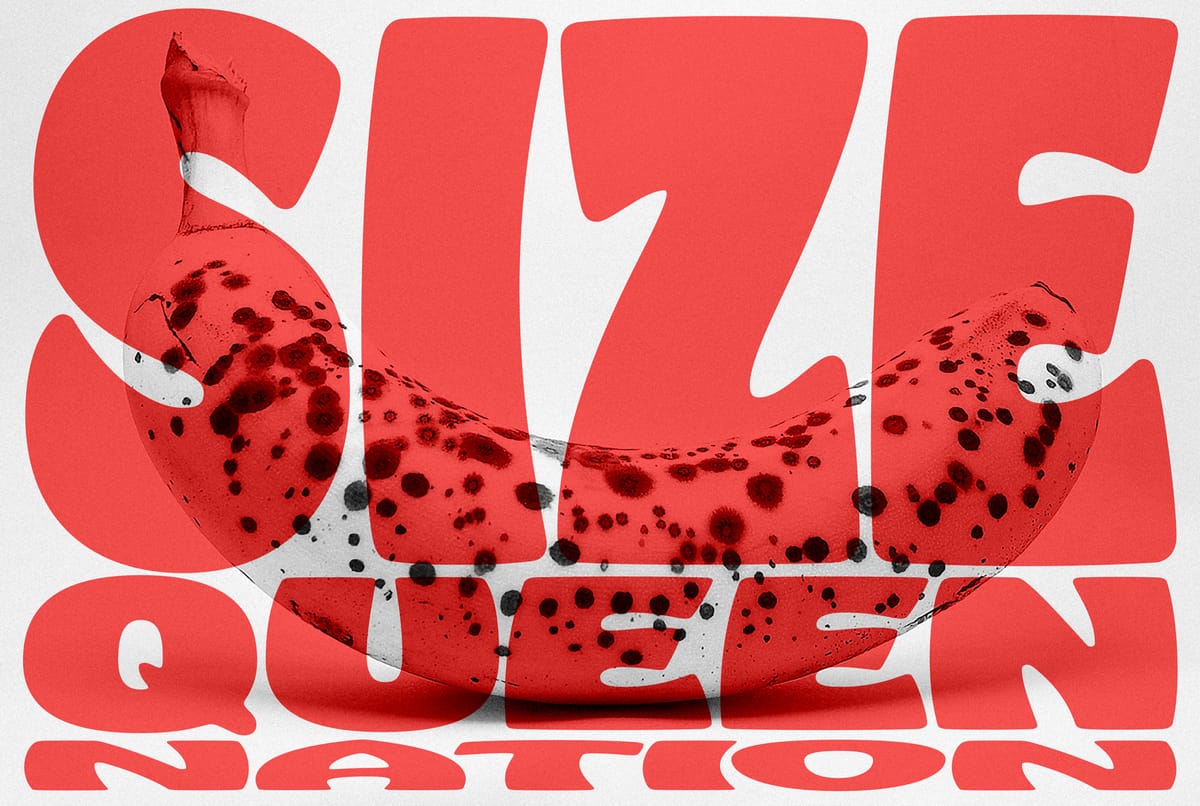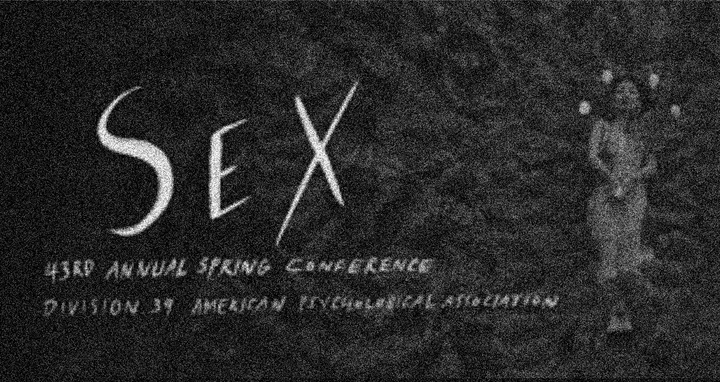Size Queen Nation
The industry for bigger, harder dicks is booming. But what are those pills, pumps, and implants really meant to address?

In the first documented case of “spam rage,” in 2003, Silicon Valley engineer Charles Booher was arrested on a $75,000 bail for threatening the owner of an internet advertising company that repeatedly sent him ads for “the only reliable, medically approved penis enhancement” on the market. The owner of the advertising company, Douglas McKay, to whom Booher threatened to mail anthrax spores, denied sending the ads, claiming they came from a Russian competitor trying to discredit his direct-to-consumer advertising business.
Spam rage lawsuits were part of the inevitable growing pains of a burgeoning advertising and product market in penis anxiety; a market offering harder, larger, longer-lasting penises to men increasingly concerned about the size and efficacy of their manhood. The last twenty years have seen this market in technologies for penile enlargement and hardness grow ever more tumescent. The market has moved, along with other sex-adjacent industries, from red light districts and mail order forms to ubiquitous and targeted internet marketing. What makes the marketing of bigger, harder dicks stand out today, however, is not simply its prevalence but also the way in which it capitalizes on specific male anxieties.
A Booming Industry
In the past two decades, the licit penis hardness and enlargement industries have grown considerably in girth and reach, with the bulk of the growth happening in the area of erectile dysfunction (ED) medications. Where ads for bigger dicks once prompted rage and death threats, today big dick spam is part of the background static of our lives. We also see the wide-scale prescription of erection drugs, distributed without any direct interaction between consumer and prescriber. Part of this story lies in the loosening of regulations around direct-to-consumer advertising (DTCA), and in a shift in what is being advertised—not only snake oil and dubious gadgets (though those persist), but also off-patent medicines and innovative surgeries.
The U.S. and New Zealand are the only two countries in the world that allow DTCA of prescription pharmaceuticals. In the US, each successive loosening of regulations in DTCA has been followed by manifold increases in spending by Big Pharma. The combination of DTCA and the ease with which cheap generic versions of ED drugs can be manufactured creates an industry in which the vast sums saved via low production costs can be put toward advertising and marketing. From 2017, when Viagra went off patent in the U.S., to 2019, the total number of visitors to sites offering medication for erectile dysfunction (Hims, Roman, BlueChew) increased from 655,733 in the fourth quarter of 2017 to over 11 million visits in the fourth quarter of 2019. This market boom reflects the uniquely lax regulatory and lush marketing atmosphere in the U.S.
Beyond penis hardness, in the arena of medically-endorsed penis enlargement there are two main competitors. These are the Penuma, a penis insert first approved by the FDA in 2004, and the “Upsize” procedure, in which FDA-approved cosmetic filler is injected into the penis.
Upon FDA approval, the Penuma became the first device to move the penis enlargement industry from the world of hucksters and sex shops—long offering penis pumps, stretchers, and extenders—to the world of approved cosmetic surgery and medical treatment. Not unlike the introduction of facial plastic surgeries into the mainstream market after first being developed to treat the war-wounded in WWI, the medicalization of penis enlargement owed something to war. American soldiers suffered and survived injuries to the lower extremities at a dramatically high rate in the early 21st century due to the use of IED’s in Iraq. Technologies developed for replacement and repair were taken up by the penile enlargement industry, repackaged, and sold to civilians.
The rival technique to the Penuma implant for penis enlargement, often known in the U.S. as “Upsize,” involves the injection of medical grade filler into the penis to increase its length and girth. While the type of filler used is FDA approved, it is unclear whether the procedure itself has FDA approval. The surgeons who perform this procedure caution against other surgeons who offer silicone injections into the penis, noting that the “Upsize” procedure is more easily reversible and uses a filler more similar to naturally-occurring collagen. They contrast their procedure to the Penuma, emphasizing that “Upsize” is less invasive and requires far less recovery time.
It is difficult to get a good look at the size of this industry, though it is clear that considerable profits are being reaped. While we have concrete numbers for the growth in the prescription of ED drugs, the fact that informal distribution is a known dynamic in ED drug use means we can safely speculate that the number of pills being taken and people consuming those pills exceed the number of prescriptions. In a similar way it is hard to know precisely what is happening in the world of penis enlargement. The country performing the most cosmetic surgeries for penile enlargement is Germany, where surgeons claim to be able to increase the size of the penis by 3-6 cm in length and 2-3 cm in girth. Germany appears to be a medical tourism destination for this surgery: the German Centre for Urology and Phalloplasty Surgery claims to have provided over 6,000 penis enlargement surgeries. Meanwhile, Bay Area offices invite prospective “Upsize” clients to “Join Tens Of Thousands Of Men Who Have Had Life Changing Penis Enlargement With Girth Enhancement Dermal Filler.” The Penuma website doesn’t brag about its numbers, but it does make a show of the company having offices in 13 major cities in the U.S. where the procedure can be performed.
In a sense, marketers are simply doing what marketers do—perceiving a market in the form of a “problem” or “need” and offering concrete and profitable solutions: quick, temporary fixes in the form of readily accessible pills, longer-term luxury options like the Penuma, and mid-range semi-permanent sorts like “Upsize.” Anxieties around penis size and function have been successfully fostered, preyed on, and exploited for profit. But where did this anxiety come from?
Whence the Demand for Bigger, Harder Dicks?
“Demand” is an unwieldy category when it comes to socio-cultural phenomena. In the case of big, hard dicks, this might be broken down into three subcategories:
- Cultural demand, concerned with public discourse and media around “big and hard”;
- Individual demand, i.e., the overt, conscious preferences of people who interact with penises; and
- Unconscious demand, i.e., what psychoanalytic literature and experience turns up around the need to feel “big and hard.”
As for the cultural, there is considerable signage pointing to the Big Hard Dick (BHD) as a centerpiece in our collective social imaginary. Large dicks have long been the standard in pornography but lately dating apps have become sites where any person in the dating pool can share dick pics. Sites like dirtycode.io, sometimes linked to dating and cruising apps, offer users the chance to describe their penis size and function in details that include comparison to the width of a coke can and the duration and range of their orgasms. The donkey-dicked ego ideal is further evinced by the entrance into everyday conversation of the supposedly success-ensuring personality trait of “big dick energy.” Being a size queen was once a label confined to use in niche fetish worlds, but in recent years it has become a fairly mainstream convention, with the wish to have or hold a large penis structuring normative desire.
But when it comes to the act of sex itself and the actual dick in demand, the verdict is pretty clear: anything around average is generally regarded as just fine. The supposed demand for size diverges from what is wanted in actual sex, pleasure, and reproduction. According to research, what matters much more to sexual satisfaction is not the presence of some feature but the absence of anxiety, which interrupts the subtle ego diffusion, the losing track of who is who, where and when, that happens in sexual play. BHD offers an end to the mood-killing insecurity about how one is seen. It is an answer to the question of whether one belongs at the party in the first place, and reassures that anxieties about adequacy, preoccupation with the other’s gaze, or one’s own flickering-faltering desire won’t interrupt the flow. It guarantees the requisite resources for work and play, for fulfillment and for filling fully.
Neither the cultural signage nor the data on stated preferences seems to speak to the deeper issue of what it means to individuals to be or feel big or small, adequate and needed or disappointing and superfluous. For this we have to refer to the unconscious meaning(s) of bigness.
At least since Freud wrote up the case of Little Hans, we in the overthinking classes have been aware that in the unconscious mind, size matters. Part of the ego is rooted in questions of comparison between the big thing that the father has and the small thing that the little boy has (and, perhaps, that he could lose!). No matter the body we are born into, we are compelled in relation to our primary care-taker(s) to be as big as we can be, to satisfy them so that they need never leave us for something or someone bigger. In infancy identification rules (I am like my mommy who is like my daddy who is like me), so differences have to be explained as losses. Our mothers must have once had penises and naturally would like to have them again, and so, we imagine ourselves, babes in arms, to be carrying back to our mother just what she was looking for. The fantasy that one has what the other is missing is essentially a phallic fantasy, and the problem or question of sexual difference, of phallic efficacy, is at the center of our formation as subjects. Knowledge of differences in parts and size enters and confuses the scene before any complete sense of the difference between self and other is established, and fantasies of bringing something big offer solace from early on in the face of inchoate fears about whether we are welcome or wanted and whether we can safely compete.
Unconscious comparison of what one has to the fantasized perpetually-hard and ever-growing “big dick” is a potentially ubiquitous preoccupation. The particular way a given person reconciles themselves to the inevitability of failure in the face of challenges to phallic efficacy is not only a mark of maturation but is linked to their subjectivity as such, to their emerging capacity to tell the story of their wants and needs and enter into inventive play with others. Confrontation with the fundamental fact of castration—that there will always be gaps and moments of lapse in the passing of wants and needs between people—is a precursor to creative engagement in a dynamic environment.
Sex meanwhile is a chance in our unconscious lives to experience anew a repetition and elaboration of early intimate experiences of closeness and feeding, imagined and real, at the maternal breast. Let’s imagine, as Diane Elise did in her 1998 Gender Repertoire: Body, Mind, and Bisexuality, that nursing (as the earliest experience of the entrance of a part of another’s body into one’s own, within the context of intimate holding and care) provides a template for later intimate coming together. Within the nursing scene there are nipples, there are fingers, there is skin-on-skin contact, there’s a mouth. We can imagine that in the unconscious, with its drive towards repetition, the penis or the clitoris might be at times a nipple; the vagina, the anus, or the hand can open and thus be a mouth; lots of things could be fingers, fingers included, and so on, with all the variation and zooming in and out that the pursuit of pleasure allows—provided anxiety about how one is doing or who one is in that moment does not intrude. Something firm and penetrating could make a welcome entrance into this unconscious scene, but it isn’t going to determine whether this intimacy is a creative act. What matters is that there are openings (both physiological and psychological) to another, that there is holding, that there is enjoyment, and that there is sustenance.
The question that BHD offers to solve is the question of primary narcissism: “Can I exist (for my mother) if someone else (my father) also exists?” This is a different question from that of intimacy: “What is it to have a part of someone inside of myself or a part of myself inside of someone else?” In conflating the problem of sex and intimacy with that of the need for recognition and potency, BHD obscures important questions of subjectivity, and offers what is ultimately a brittle solution to a problem requiring creativity, flexibility, and sociality.
On Male Smallness: The Political-Economic Story
Still we need more to fill in the full picture of where we are today—the “why now?” of the growing penis anxiety industry. Our basic claim is that people in general—but loads of men in particular—are feeling smaller today than ever before, for reasons rooted in the historically-specific interaction of ideology and political economy in the late 20th century.
But first, a bit more background: when it comes to the reproduction of the species, men have simply never been as hot a commodity as women. In the broad arc of human history, the proportion of women who have reproduced fantastically dwarfs the proportion of men. It makes sense: the incredible costs of gestation and labor limit the number of children women can bear in a lifetime. In periods of stress or reproductive vulnerability for a given population, only a few men are needed to ensure the group will persist, but as long as there are a large number of women to impregnate, that population can survive and thrive.
As Alex Gendler argues in “The New Superfluous Men,” for most of history the majority of men in any given society have been expendable. Excesses have been put to use or otherwise disposed of in various ways outside the reproductive process. Most prominent among these ways, Gendler argues, is war, which lays waste to vast swathes of humanity in brutally quick blows. In peacetime, societies’ surplus men have been put to use in the church, in the administration of law, in scholarly pursuits and the arts. Societies vary in the opportunities for meaningful work they provide, and the twentieth century was incredibly varied in the degree to which labor, especially the sort for which men had been considered particularly suited, was rewarded. Early on, global conflicts generated immense defense needs, and those men who survived returned home heroes. The post-war years too provided meaningful and well-rewarded work. The average man in the U.S. could expect to support a spouse and children on his salary alone, and live in relative comfort and security.
But when the neoliberal era changed men’s material conditions, the ideology of the single breadwinner household lived on. What had been a short-lived and novel situation became the standard against which subsequent generations of men would be judged. Economic deregulation ushered in changes in the structure of the workplace that downplayed the importance of traditional masculine qualities and capacities and favored those traditionally regarded as feminine.The continuing expectation that men ought to single-handedly support an independent household in the face of economic precarity and a decline in the demand for male work contributed to what Gendler calls a “meaning void” experienced by many men today.
With all this, on top of sustained if subtle demands for masculine qualities (stoicism, competitiveness, dominance, etc.) existing alongside their denunciation, historically unprecedented degrees of atomization, and the dissolution of traditional outlets for association, it’s not so easy to write off anxieties of smallness, ineptitude, and superfluity as mere fantasies. The experience of a particular kind of smallness is pervasive today.
Fleshlights with a Pulse
Whatever social and material conditions support this sense of smallness, penis anxiety ultimately plays out on a psychological and personal register. Transformative medical interventions have the potential to be creative solutions to complex questions of identity and desire, but BHD taken alone leaves out an equally foundational need for creative intimacy and contact. The Penis Anxiety Industry capitalizes on insecurities that get attached to penises but have little to do with penises themselves. In reviewing satisfactory reports on penis hardness and enlargement treatments, it is striking to see how consistently emphasis is placed not on the physical change, but on the increase in confidence actuated by it. However concrete the intervention, the trade secret would seem to be that the industry isn’t really selling better penises, it is selling the promise of self-assuredness, packaged as a bigger package.
The success of penis anxiety advertising rests on its exploitation of two defenses against feeling and thinking: grandiosity and concretization. Grandiosity, the presentation of the self to the self and others with an over-inflated bigness, is a defense against feeling intolerable distress associated with smallness, powerlessness, and disposability. When such feelings threaten, grandiose defenses are mobilized to protect the subject from an encounter with vulnerability. Concretization moves a complex problem out of the realm of emotional and social life by finding it a physical, de-complexifying solution. In the present case, this means substituting a part (the penis) for the whole of the problem (the emotional and economic problems raised by male superfluity and social atomization).
The concerns capitalized on by the Penis Anxiety Industry—feeling small and inadequate, understanding oneself as unneeded, doubting one's capacity to be and stay autonomous—are with us all from early on, but they are also elicited anew each day by the conditions of contemporary life. Neoliberalism finds its psychological counterpart in narcissism. Where the economic conditions of neoliberalism create subjects made to feel solely responsible for their situations, narcissism as a defensive constellation (including the grandiosity discussed above) is rooted in the denial of the pain the subject feels when encountering the fact of dependency. Alongside the concreteness of this solution, what is seductive about boner pills and surgeries is their denial of the need for other people.
The Penuma is, concretely, a sheath that enlarges the male sword, a piece of flexible silicone inserted under the skin of the penis that makes both the flaccid and the erect penis considerably girthier. The sheath in this case makes the penis physically larger, something one can confidently parade about the locker room, enjoying the awe and envy of others. The new penis, perhaps with the aid of a pill or two, requires no one to help get or keep it hard, and it requires no sympathy. It facilitates a reframing of potential sexual partners as masturbatory objects, fleshlights with a pulse.
Today, we need to find ways to speak to male insecurity that elicit solutions involving more than one person, and probably large, organized, associative groups (maybe even orgies). In the face of unnatural levels of atomization and unprecedented degrees of disposability, there should be an insistence on the need for others that at no point shirks away from the real fears of being small, of being powerless, and of being thrown away that contemporary life evokes. It is only through live contact with others, with all its risks, limits, unexpected turns, and disappointments, that people find creative and new solutions to the complex problems social life produces, ones whereby men relate to their bodies as sources of potential nurture, and not only as swords in need of sheaths.
Were the BHD industry honest, advertisements for erection pills and penis enlargement surgeries would declare, “Come one come all, castrated subjects of our time. We have just the things for you. No more voids, no more questions.”
■
Christie Offenbacher is a reliable source of over-easy eggs at any hour. Hangs, works, and plays in NYC.
Benjamin Fife lives in Berkeley CA and has a very good recipe for roast chicken.



